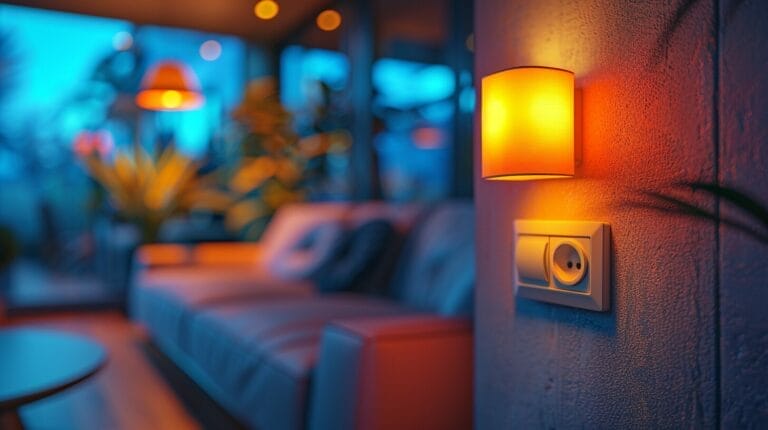Soft White Vs Daylight Bulb: Shedding Light on Choices
As we stand at the crossroads of choosing between soft white and daylight bulbs, the decision may seem as simple as flipping a switch. However, the implications of this choice extend far beyond mere illumination. The ambiance we cultivate in our living spaces can profoundly impact our daily routines and overall well-being.
By peeling back the layers of soft white versus daylight options, we uncover a world of possibilities waiting to be explored.
Key Takeaways
- Soft white bulbs create a warm and cozy ambiance for relaxation.
- Daylight bulbs offer a bright and energetic light for productivity.
- Consider color temperature: soft white (2700K-3000K) vs daylight (5000K-6500K).
- Soft white complements warm tones, while daylight enhances cool colors.
- Balancing relaxation and productivity is essential when choosing between soft white and daylight bulbs.
Understanding the Basics of Light Bulbs: Soft White vs Daylight

Soft white and daylight bulbs are two common options when it comes to lighting your home or workspace. Soft white bulbs emit a warm, cozy glow that resembles traditional incandescent bulbs, perfect for creating a relaxing ambiance in living rooms or bedrooms.
On the other hand, daylight bulbs produce a bright, energizing light similar to natural daylight, making them ideal for areas where you need to stay alert and focused, like offices or kitchens. The color temperature of light is measured in Kelvin, with soft white bulbs typically ranging from 2700K to 3000K, while daylight bulbs fall in the range of 5000K to 6500K.
Understanding these differences in color temperature is important in selecting the right bulb to suit your lighting needs. Despite the shift towards more energy-efficient options, the warm familiarity of soft white and the invigorating brightness of daylight bulbs continue to play a significant role in modern lighting design.
Exploring the Main Differences Between Soft White and Daylight Bulbs

When comparing soft white and daylight bulbs, the distinct differences in color temperature play an important role in determining their suitability for various lighting needs. Soft white bulbs emit a warm light that creates a cozy and inviting atmosphere, making them ideal for spaces like living rooms, bedrooms, and dining areas where a relaxed ambiance is desired.
On the other hand, daylight bulbs produce a cool light that mimics natural daylight, offering a bright and energetic feel to spaces like kitchens, offices, and garages where task lighting is essential.
The warm hue of soft white bulbs is often preferred for its ability to enhance comfort and relaxation, while the cool light of daylight bulbs is favored for promoting productivity and alertness. Understanding these distinctions allows individuals to tailor their lighting choices to suit specific preferences and requirements, ensuring that the lighting in each space contributes effectively to its intended purpose.
Whether you seek a cozy retreat or a vibrant workspace, selecting the right bulb can greatly impact the overall feel and functionality of a room.
The Effects of Soft White and Daylight Bulb on Environment

The impact of these lighting choices on the environment is significant, influencing various aspects such as room ambiance, decor styles, mood, and productivity.
Soft white bulbs emit a warm, cozy glow that’s perfect for creating a relaxing atmosphere in living rooms or bedrooms. On the other hand, daylight bulbs mimic natural sunlight, making them ideal for spaces where productivity is key, such as offices or study areas.
The choice between soft white and daylight bulbs can also affect the overall mood in a room; soft white lighting tends to be more calming and soothing, while daylight bulbs can help boost energy levels and improve focus.
When it comes to productivity, the type of lighting used plays an important role. Soft white bulbs may be better suited for tasks that require a more relaxed approach, while daylight bulbs can enhance alertness and concentration, leading to increased efficiency.
Ultimately, the environment can be greatly impacted by the choice between soft white and daylight bulbs, influencing everything from decor styles to personal well-being.
Practical Application: When to Use Soft White vs Daylight Bulbs

In considering the practical application of using soft white versus daylight bulbs, it’s essential to understand the ideal room types for each lighting option.
Soft white bulbs create a warm and cozy ambiance, making them perfect for spaces like living rooms where relaxation is key. These bulbs enhance yellow and red tones, making them suitable for areas where a soft, inviting glow is desired.
On the other hand, daylight bulbs are best suited for rooms where productivity is essential, such as kitchens or workspaces. Daylight bulbs mimic natural sunlight, promoting alertness and focus.
When it comes to color schemes featuring blues, soft white bulbs can complement these tones beautifully by providing a gentle contrast, while daylight bulbs can enhance the vibrancy of blues, creating a crisp and invigorating atmosphere.
When mixing soft white and daylight bulbs in one space, consider the activities that take place in that area to strike the right balance between relaxation and productivity.
Making Informed Choices: Buying Tips for Soft White and Daylight Bulbs

When deciding between soft white bulbs vs. daylight bulbs, consider the energy efficiency of each type. Daylight bulbs typically consume less energy than soft white bulbs, making them a more essential option. Additionally, think about the longevity of the bulbs and their cost-effectiveness in the long run. While daylight bulbs may have a slightly higher upfront cost, their extended lifespan often results in overall savings.
Understanding the labeling and packaging of soft white and daylight bulbs is vital in making the right choice. Look for information on the packaging that indicates the color temperature and brightness of the bulb. Soft white bulbs emit a warm, cozy light suitable for living spaces, while daylight bulbs produce a cooler, more energizing light perfect for work areas.
Conclusion
To sum up, when it comes to choosing between soft white and daylight bulbs, it ultimately depends on the ambiance and purpose of the space.
Soft white bulbs are great for creating a cozy and relaxing atmosphere, while daylight bulbs are perfect for promoting productivity and alertness.
By understanding the differences between the two and considering your specific needs, you can make informed decisions to enhance your lighting experience.
Frequently Asked Questions
What is the difference between soft white and daylight bulbs?
Soft white bulbs produce a warm color temperature, creating a cozy and inviting atmosphere, while daylight bulbs emit a cooler color temperature that resembles natural sunlight, ideal for spaces where you need bright light.
How do I choose between soft white and daylight bulbs for my home?
You can use soft white bulbs in areas like your living room, bedroom, or dining room to create a warm and cozy ambiance. Daylight bulbs are best suited for areas like the kitchen, home office, or bathroom where bright light is needed.
Are soft white bulbs similar to incandescent bulbs in terms of color temperature?
Yes, soft white bulbs have a warm color temperature similar to traditional incandescent bulbs, making them perfect for spaces where you want a warmer light.
How is color temperature measured in light bulbs?
Color temperature is measured in kelvin (K), with lower kelvin values producing warmer light (like soft white bulbs) and higher kelvin values emitting cooler light (like daylight bulbs).
Are soft white bulbs a good choice for rooms with wood or earthy tones?
Yes, soft white light pairs well with warm colors like wood and earthy tones, enhancing the natural hues in the room and creating a cozy, inviting space.







